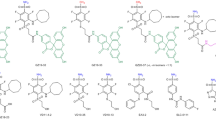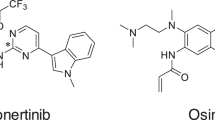Abstract
The present studies were initiated to quantitate the oxygen dependence of bioreductive metabolism-induced binding of EF5, a pentafluorinated derivative of the 2-nitroimidazole, etanidazole. Two different assays were compared: first, radioactive drug incorporation into cell lysates, which provides a direct measure of drug metabolism or uptake; second, monoclonal antibody detection of cellular macromolecular adducts of EF5 after whole cell permeabilisation and fixing. The antibodies (a single clone designated ELK3-51) were conjugated with the fluorescent dye Cy3, with fluorescence determined by fluorescence microscopy and flow cytometry. For the two cell lines tested (V79 Chinese hamster fibroblasts and 9L rat glioma), the oxygen dependence of binding was found to be the same for the two techniques. Using the antibody binding technique, the fluorescence signal was highly reproducible between experiments, resistant to light or chemical bleaching and stable over time following cell or tissue staining. Flow cytometric analysis of cells from rat 9L tumours treated with EF5 in vivo or in vitro showed a distribution of fluorescent signal which was very compatible, on both a relative and absolute basis, with the in vitro results. Our results indicate that immunofluorescent techniques provide a quantitative assay for bioreductive drug adducts, and therefore may be able to measure the absolute oxygen concentration distribution in cell populations and tissues of interest.
This is a preview of subscription content, access via your institution
Access options
Subscribe to this journal
Receive 24 print issues and online access
$259.00 per year
only $10.79 per issue
Buy this article
- Purchase on Springer Link
- Instant access to full article PDF
Prices may be subject to local taxes which are calculated during checkout
Similar content being viewed by others
Author information
Authors and Affiliations
Rights and permissions
About this article
Cite this article
Koch, C., Evans, S. & Lord, E. Oxygen dependence of cellular uptake of EF5 [2-(2-nitro-1H-imidazol-1-yl)-N-(2,2,3,3,3-pentafluoropropyl)a cet amide]: analysis of drug adducts by fluorescent antibodies vs bound radioactivity. Br J Cancer 72, 869–874 (1995). https://doi.org/10.1038/bjc.1995.426
Issue Date:
DOI: https://doi.org/10.1038/bjc.1995.426
This article is cited by
-
Synthesis of a 2-nitroimidazole derivative N-(4-[18F]fluorobenzyl)-2-(2-nitro-1H-imidazol-1-yl)-acetamide ([18 F]FBNA) as PET radiotracer for imaging tumor hypoxia
EJNMMI Radiopharmacy and Chemistry (2022)
-
Transiently hypoxic tumour cell turnover and radiation sensitivity in human tumour xenografts
British Journal of Cancer (2022)
-
Evaluation of CAIX and CAXII Expression in Breast Cancer at Varied O2 Levels: CAIX is the Superior Surrogate Imaging Biomarker of Tumor Hypoxia
Molecular Imaging and Biology (2016)
-
The differential effects of metronomic gemcitabine and antiangiogenic treatment in patient-derived xenografts of pancreatic cancer: treatment effects on metabolism, vascular function, cell proliferation, and tumor growth
Angiogenesis (2016)
-
PET–CT for radiotherapy treatment planning and response monitoring in solid tumors
Nature Reviews Clinical Oncology (2011)



